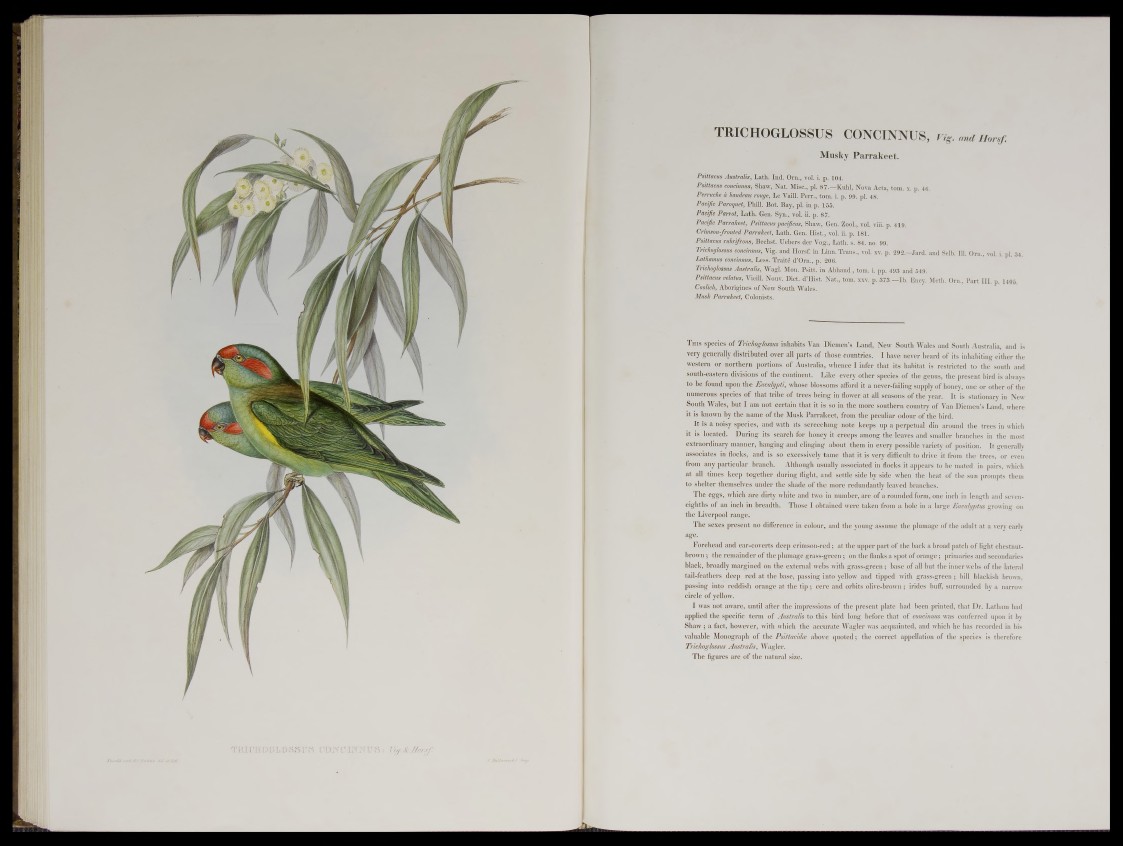
TRICHOGLOSSUS CONCINNUS,
Musky Parrakeet.
Psittams Australis, 104.
Psittacui co, i n « u , n &)m -■ Aita. iom-.fr. tT A .*
Pf>fV<W:%i htm & tat rmitra,.EetyaitP Bsaaitofflff p 99s pl^JsHrV*"
PmtJ P o o ,i sM j iw j^ tR w 'p l 'n S M l» ■ "
P&'ifi i H I
l'<Kif Pm r jr iP J ' Ii<7t )<ftSvs
( I mi’m fir n h i 1 arrJ l ,"
Pittysis rulrifrons, lit sfll@|^ |j|ap& 8
In-jHjhwuf Ora., vol. I pi. 84.
Lathamus conciamus, LeSfgTraitS i- 0i;n.3 p. 206-
Trichoglosstis Australis, WaglV'I^on. Bgjffijn.' A^haMd.}^ ^ ^ ^ g r^93j1and 549.
# ”$«*» velatus*, 0m./Part I I I p. 140S.
CooHcK, Aborigines o^Me,w/ South^Wales.
Musk Parrakeet, Colonists.-
THij3^j)e^^ Van Diemen’s Land, New S tfutfeyile^ ind South Australia, and &:
v very parts of those countries," I have inever heard of its inhabiting either the
western^o^northern portions of Australia, ^M |^ L in f e r that its habitatds restricted to the south and
s o u l h ^ e ^ e r ^ ^ ^ ^ ^ j g | f e | ^ ^ S i ' Like, every other' specimjp the genus, the present bird' is always
to b^fQgJdCppjn the Eucalypti, whose blossoms'^ord it A never-fai]ing;|upply of honey, one or other of the
numerous species of th a t tribe of trees being in flower at all 'seasons, of the year. I t is stationary in New
South Wales,, hfttjfi am not certain that it is j | | l the more southern country of Van Diemen’s Land, where
i£i§ known by the name/Jfijbe Musk Parrakeet; Qdo
’ It is a noisy species, and with its screeching note keeps up a p e r p e t u a ^ l ^ ^ ^ S f e i e trees in which
located, ©urrag’ its search for ho|^y^|^|-eeps among the leaves and smaller branches in the most
extraordinary manner, hanging and clinging1 them in every ^ o s ^ e f v a r i e t ^ ^ ^ ^ ^ p K l t generally
associates |g flocks, a n d ^ S # ^ |^ s i v i y f teime that it is ver^d^ Mf;fo^drive trees, or even 1t e any particular branch. Althoughl ustallyrassociated in flocks it appears to be mated in pairs, which
at all times keep together durin^*hight, and settle side by side when the heat of the sun prompts them'
to shelter themselves under the shade of the more redundantly leaypdf branches.
The eggs, which are dirty white and two in num b er,^pe/of• a3r.^^dMf6rm, one inch in length and seven-
eighths of an inch-in breadth. Those11 obtained were taken!fr8l^ | ^ ^ ^ ^ ^m r g e Eucalyptus growing on
the Livei^opJl^ahM^I
The sexes present no difference in colour, ahd^h^^rag«assui^^^^pidmage |of the adult a t a very early
age.
Forehead and ear-coverts deep crimson-red; at the upper part p l l ie back a-broad patch of light chestnut-
brown ; the remainder of the plumage grass-green p ©ii|jhe flanks a spot of orange; primaries and secondaries
black, broadly margined on the external wehs^whh'gr^s-green; webs of the lateral
tail-feathers deep red at the base, passing in t^yMqw l^ ^ |tippod with .grass-green J, bill blackish brown,
passing into reddish orange a t the tip ^^iitndg orbits olive-brown ; irides huff, surrounded by a narrow
* carclMdf ycUdw«
I was not aware, until after the impressions of the present plate had been printed, that Dr. Latham had
applied the specific term of Australis to this bird longs before that of concinnus was conferred upon it Ly
Shaw ; a fact, however, with which the accurate Wagler was acquainted, and which he has recorded in his
valuable Monograph of the Psittacidee above quoted; the correct appellation of the species is therefore
Trichoglossus Australis, Wagler.
The figures are o f the natural size.